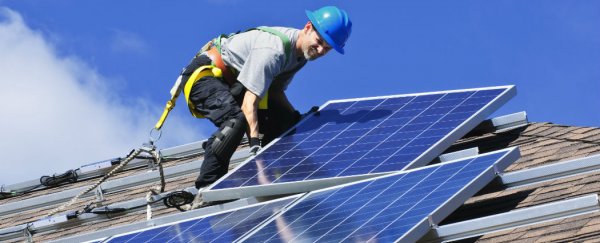A new program is underway in California, and it aims to have solar panels installed on the roofs of 1,600 homes in disadvantaged neighbourhoods by the end of the year. And the best part is the residents won't be footing the substantial upfront costs of solar installation - companies are being encouraged to 'pay' for their polluting ways by contributing to the state's impressive uptake of solar power technology.
"Run by Oakland nonprofit Grid Alternatives, the effort will install home solar arrays in low-income neighbourhoods, using $14.7 million raised through California's cap-and-trade system for reining in greenhouse gas emissions," the San Francisco Chronicle explains, referring to a new law that requires factories, power plants, oil refineries, and other big polluters in California to buy credits for each ton of pollution they release into the atmosphere.
This is one of a range of programs and incentives that has helped make California the best state in the US for solar, says Brian Merchant at Motherboard, but the difference here is that while the previous programs encouraged and enabled the rich and upper-middle class locals to dig into their pockets and invest in the future of renewable energy, this project makes it possible for those who aren't so well-off to get a look-in too.
"Most homeowners are asked to make small contributions for the installation, such as agreeing to feed the crew installing the array, or agreeing to help with the installation themselves. Otherwise, it's free," The San Francisco Chronicle reports.
Merchant reports that anyone who lives in a Californian neughbourhood that's been deemed 'disadvantaged' qualifies to go on the list to receive the solar panels, and then it's just a case of high-polluting companies and factories signing up to get involved.
"It's not charity, either, exactly," says Merchant. "It's public policy. Very good policy." These companies have to fork out either way, according to the cap-and-trade law, so they might as well capitalise on the good public relations opportunities this program offers up. Once those solar panels are installed, these working-class families will be saving up to $1,000 each year in electricity costs, according to the The San Francisco Chronicle, which is a saving that should not be exclusive to those who can afford the initial $15,000 installation cost.
If it all sounds a little too good to be true… congratulations, your cynicism is not unfounded. Merchant reports at Motherboard that the funds aren't exactly there to make this happen without donations from solar panel companies and volunteers giving up their time to help with the installation. But it's just the beginning. If the age of social media has taught us anything, it's that a whole lot of companies would kill for a public relations opportunity like this, so hopefully it'll take off. After all, solar power isn't just better for the environment now, it's actually just the smarter choice.
